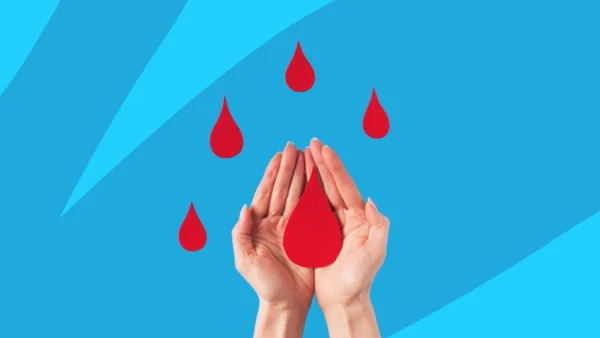Do you know your blood type? If you do not, you are like most people. If you’re ever in a life-threatening situation requiring a blood transfusion, your blood type will always be checked. That’s because if you’re given an incompatible blood donation, your immune system will attack the donor blood by forming antibodies to destroy the unrecognized “foreign invaders.”
Of the eight most common blood types, some are rarer than others. What’s more, the type of blood you can receive from a donor is dictated by your own blood type. Here’s what you need to know.
RELATED: What does your blood type mean for your health?
What are the different blood types?
There are four major blood types grouped by the ABO blood group system. This system categorizes blood types based on the presence or absence of specific markers (sugars) on red blood cells called Antigen A or B. The four main blood types are A, B, AB, and O. The most common ABO blood group is O, followed by group B, group A, and group AB (the least common).
According to Eric Ascher, DO, a family medicine physician at Lenox Hill Hospital in New York, blood types also indicate what antibodies (proteins that attack foreign red blood cells) your blood has. For example, blood type A has A antigens and anti-B antibodies; the opposite is true for type B blood. Type O has no antigens, but both antibodies, and Type AB has both antigens, and no antibodies, Dr. Ascher explains.
Blood types are further classified according to the Rh system, which identifies the presence or absence of the Rhesus (Rh) factor (a protein antigen) on the surface of red blood cells. Each of the four blood types can be Rh-, meaning there is no Rh factor cell surface protein on your red blood cells, or Rh+, meaning Rh factor is present. It is more common to have Rh+ blood than Rh- blood.
Using these two categorization systems, there are eight blood types:
- A positive blood (A+): Red blood cells have the A antigen and Rh factor
- A negative blood (A-): Red blood cells have the A antigen, but do not have the Rh factor
- B positive blood (B+): Red blood cells have the B antigen and Rh factor
- B negative blood (B-): Red blood cells have the B antigen, but do not have the Rh factor
- AB positive blood (AB+): Red blood cells have the A and B antigens and Rh factor
- AB negative blood (AB-): Red blood cells have the A and B antigens, but do not have the Rh factor
- O positive blood (O+): Red blood cells do not have the A and B antigens and have the Rh factor
- O negative blood (O-): Red blood cells do not have the A and B antigens, but do not have the Rh factor
What is the rarest blood type?
Of the eight blood types, Group AB- is the least common blood type in the U.S.—and worldwide. According to the American Red Cross, fewer than 1% of Americans have AB negative (AB-) blood, and fewer than 4% have AB positive (AB+) blood.
However, not everyone’s blood falls into these eight categories. Certain rare blood types are unique to specific racial and ethnic groups; for example, U-negative and Duffy-negative blood types are only found among African-Americans. One of the rarest blood types is Rh-null (lacking all Rh antigens), according to the Cleveland Clinic. Sometimes referred to as “golden blood,” fewer than 50 people in the world have this type of blood.
Additionally, the percentage of a population that has a specific blood type varies by ethnicity. For example, according to research:
- Blood type O: This blood type is the most common worldwide, including in the United States and Western Europe; among Indigenous populations in Central and South America, type O blood ranks at nearly 100%.
- Blood type A: Type A ranks as the second most common blood type worldwide; it is common in Central and Eastern Europe—about 45%-50% of the population in Austria, Denmark, Norway, and Switzerland have Type A blood, while about 40% of the population in Poland and Ukraine have Type A blood. It’s found in more concentrated amounts in small populations, such as 80% of the Blackfoot Indians of Montana.
- Blood type B: Type B ranks as the third most common blood type worldwide. It’s more common among Chinese and Indian populations (25%) than European and American populations (10%).
- Blood type AB: Type AB blood is the rarest blood type worldwide; it is most common (10%) among populations in Japan, parts of China, and Korea.
According to one study, over a 10-year period in the United States, the highest percentage of Type O donors were Hispanic (57%), North American Indian (55%), and Black (50%). Among all blood type donors, the Rh-positive (Rh+) blood type was more common than the Rh-negative (Rh-) blood type, with the highest percentage of Rh- blood being found in Caucasian donors (17.3%).
What makes blood rare?
A blood type is considered to be rare when it is only found in a small percentage of the population, says Jared Braunstein, DO, an internist at Medical Offices of Manhattan. That’s defined by the American Red Cross as 1 in 1000 people. Typically, rare blood is missing one common antigen that most individuals possess or it’s missing a combination of antigens.
Rh negative (Rh-) blood is considered rare because it is only present in a small percentage of the population (about 15% worldwide), says Dr. Braunstein. Having a rare blood type is neither good nor bad, he adds (although it might be harder to find a donor if you need a blood transfusion).
How are blood types inherited?
Both the ABO and Rh blood types are inherited by your biological parents. The A and B antigens on red blood cells are made by two different enzymes, which are encoded by different alleles (versions), of the same gene. According to the University of Utah’s Genetic Science Learning Center, “The A allele codes for an enzyme that makes the A antigen, and the B allele codes for an enzyme that makes the B antigen. A third version of this gene, the O allele, codes for a protein that is not functional; it makes no surface molecules at all.”
Everyone inherits one allele from their mother and one from their father. The combination of these two alleles determines your blood type. It is possible to have a different blood type than your parents. For example:
| Father Type A | Father Type B | Father Type AB | Father Type O | |
| Mother type A | Child Type A
or O |
Child Type A, B, AB, or O | Child Type A, B, or AB | Child Type A
or O |
| Mother Type B | Child Type A, B, AB, or O | Child Type B
or O |
Child Type A, B, or AB | Child Type B
or O |
| Mother Type AB | Child Type A, B, or AB | Child Type A, B, or AB | Child Type A, B, or AB | Child Type A
or B |
| Mother Type O | Child Type A
or O |
Child Type B
or O |
Child Type A or B | Child Type O |
The Rhesus factor is inherited similarly. If both of your parents are Rh-, you will be Rh- as well. But if one of your parents is Rh+, your blood type could be Rh+ or Rh-. If both your parents are Rh+, it is possible for you to be Rh-, but it’s less likely.
Ethnicity and rare blood types
Blood type distribution varies across different ethnic groups, says Dr. Braunstein. Data from the American Red Cross indicates that among the U.S. population, blood types percentages are as follows:
- O+: 37% Caucasian, 47% African-American, 39% Asian, 53% Latino-American
- O-: 8% Caucasian, 4% African-American, 1% Asian, 4% Latino-American
- A+: 33% Caucasian, 24% African-American, 27% Asian, 29% Latino-American
- A-: 7% Caucasian, 2% African-American, 0.5% Asian, 2% Latino-American
- B+: 9% Caucasian, 18% African-American, 25% Asian, 9% Latino-American
- B-: 2% Caucasian, 1% African-American, 0.4% Asian, 1% Latino-American
- AB+: 3% Caucasian, 4% African-American, 7% Asian, 2% Latino-American
- AB-: 1% Caucasian, 0.3% African-American, 0.1% Asian, 0.2% Latino-American
Therefore, the most common blood type among all ethnicities is O+, although percentages vary by ethnicity.
Where do donations of rare blood come from?
Blood type O- is considered the “universal donor” and is often used in emergencies when there’s not enough time to perform blood-typing tests. That’s because any person with any of the eight typical blood types can safely receive O- blood. Blood type AB+ is considered the “universal recipient,” meaning people with this blood type can safely receive any other type of blood.
It’s important for people with very rare blood types (and those with sickle cell disease) to only receive donor blood from others with the same rare blood type. Rare blood comes from human donations via people with rare blood. The American Red Cross (which supplies 40% of all blood in America) encourages individuals with extremely rare blood types to donate frequently.
To find a local blood drive or blood center near you to donate blood, visit redcross.org/give-blood.











